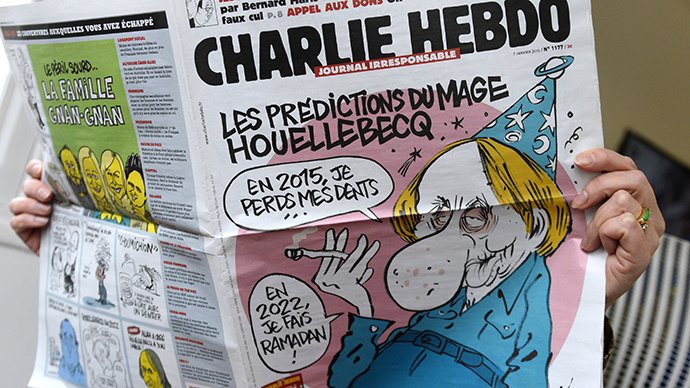Just an hour before the Charlie Hebdo attack, the French satirical magazine posted the image of an ISIS leader with the words 'best wishes.' The weekly has a history of publishing controversial cartoons of world religions, cultures, and political leaders.
Meilleurs vœux, au fait. pic.twitter.com/a2JOhqJZJM
— Charlie Hebdo (@Charlie_Hebdo_) January 7, 2015
A black and white cartoon of Islamic State leader Abu Bakr al-Baghdadi was tweeted by Charlie Hebdo just an hour before gunmen attacked the newspaper's Paris office, killing 10 journalists and two policemen.
READ MORE: 12 dead in shooting at French satirical weekly Charlie Hebdo in Paris (PHOTOS, VIDEOS)
The jihadist leader is seen raising the index finger on his right hand – a symbol which is commonly understood among radical Islamists as an allusion to 'tawhid,' the belief in the oneness of God in the Muslim religion. While holding up a single finger in this manner, militants are usually expressing their dedication to this ideology – some underlying principles of which demand the destruction of the West.
A caption on the image reads: "al-Baghdadi also wishes...especially health."
In a video which captured the yet unidentified gunmen leaving the building after the attack on Charlie Hebdo, one of them – carrying an AK47 assault rifle – is seen raising his index finger in the same manner.
Charb dans le Charlie Hebdo de la semaine. pic.twitter.com/jb2rcR5W8H
— Alexandre Hervaud (@AlexHervaud) January 7, 2015
Another recent drawing by Charlie Hebdo's editorial director Stephane Charbonnier, a cartoonist known professionally as 'Charb,' shows a bearded man with a shoulder gun making the same gesture. Its caption reads: "Still no attack in France?" followed by "Wait, we have until late January to present our wishes."
According to a police source, Charb was directly targeted in the attack, with shooters allegedly having shouted "Where is Charb?" upon entering the newsroom.
READ MORE: Charlie Hebdo attack: Chief editor Charb, cartoonists Cabu, Wolinski, Tignous killed
The French weekly, which has a circulation of 45,000 copies, is published every Wednesday, with special editions issued on an unscheduled basis. The magazine has received a number of threats, as well as actual attacks, for mocking radical Islam over the years.
"We are provocative today. We will be provocative tomorrow...Our job is not to defend freedom of speech, but without freedom of speech we are dead...I prefer to die than live like a rat. I haven't time to be afraid, I have a paper to do," Charbonnier told ABC News in 2012.
Followers of Islam believe the Prophet Muhammad cannot be captured in an image by human hand, and that any attempt to do so is an insult to Allah.
In September 2012, the paper published nude cartoons of the Prophet Muhammad, sparking worldwide protests and forcing French embassies and schools to temporarily close in 20 countries. Hundreds gathered outside the French embassy in Tehran, chanting “Death to America” and “Death to Israel,” as well as “Death to France."

Charlie Hebdo published the caricatures, saying the illustrations would "shock those who will want to be shocked." The images, which were deemed blasphemous by Muslims, were also condemned by the French government, which blamed the publication for being needlessly provocative.
READ MORE: Prophet protests: LIVE anti-Western rallies timeline (PHOTOS)
A group of Pakistani hackers claimed to have taken down the official Charlie Hebdo website on the day of publication, and vowed to do “whatever is necessary to stop blasphemous content of our holy prophet” if the French government does not take action against "so-called blatant freedom of speech."
READ MORE: Unrest feared: French mag publishes more caricatures of Mohammed
In December 2011, the magazine's Paris office was firebombed after it said the Prophet Muhammad would be guest editor-in-chief of its next issue. The publication was called “Sharia Hebdo." A Molotov cocktail was thrown through the office window, setting fire to the computer system. While no injuries were reported, the damage was extensive.
READ MORE: Prophet motive: French weekly office firebombed
In 2007, the paper was sued for inciting ethnic hatred by two separate Islamic groups. Charlie Hebdo reprinted a 2005 Danish cartoon of Muhammad with a bomb in his turban, which ignited protests.
READ MORE: French magazine sparks another controversy over Mohammed cartoons
One of the later large controversies sparked by Charlie Hebdo made international headlines in January 2013. A special issue containing cartoons on the life of the Prophet Muhammad was not warmly welcomed by French authorities. "There is no necessity to pour oil on fire," government spokesperson Najat Vallaud-Belkacem said at the time.
Among the latest newspaper covers was a cartoon mocking the birth of Christ, published ahead of Christmas celebrations in France.

